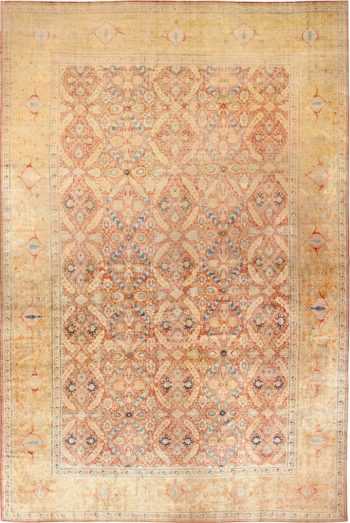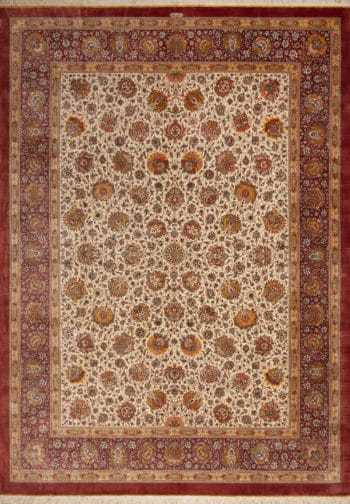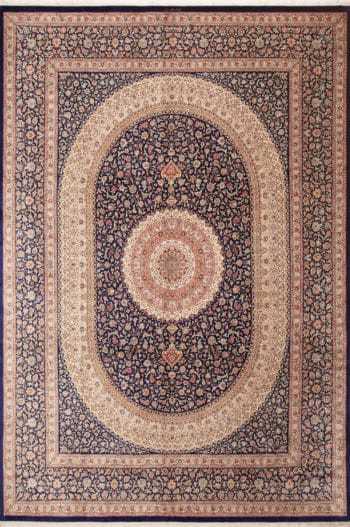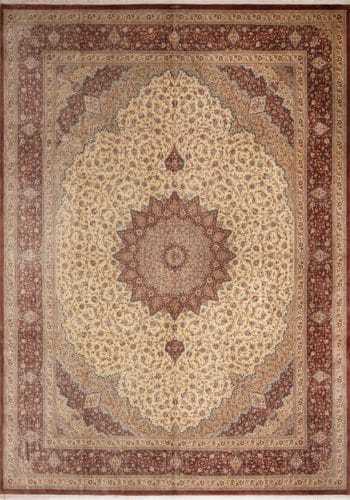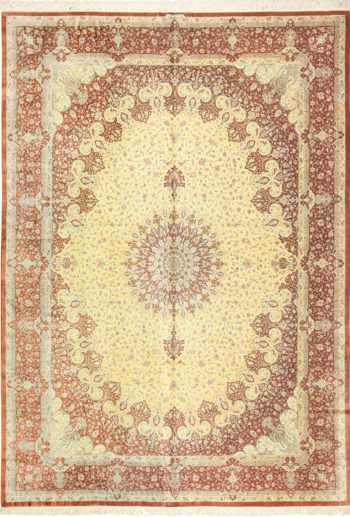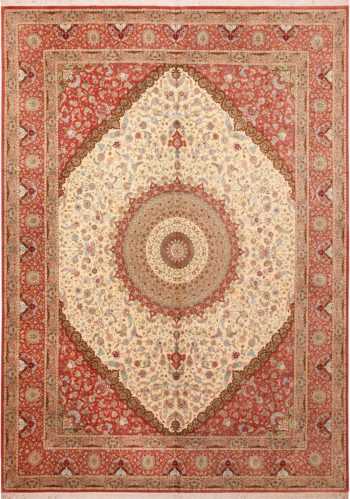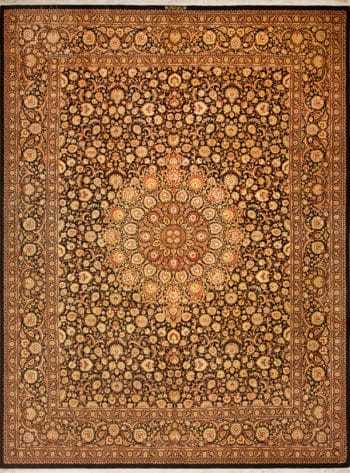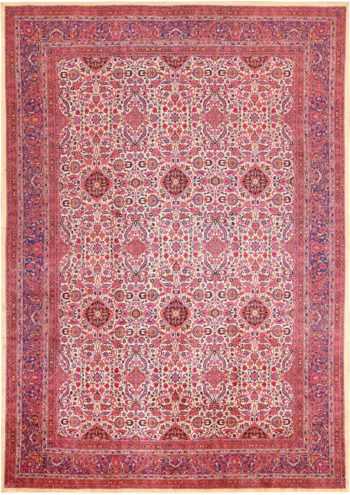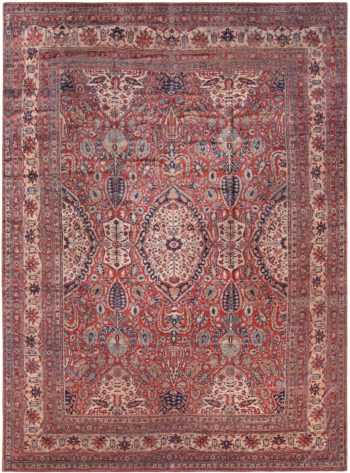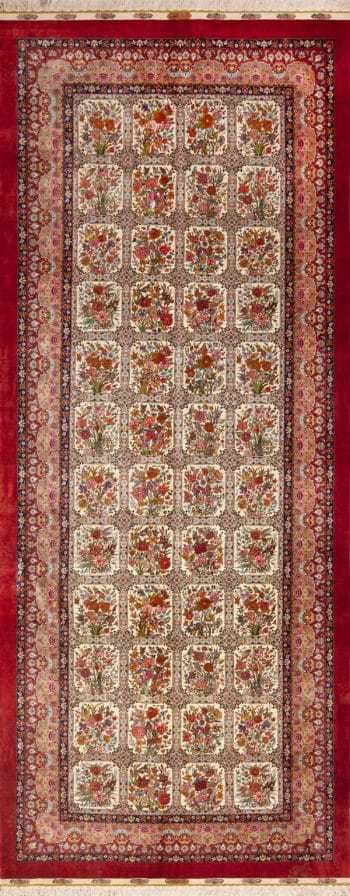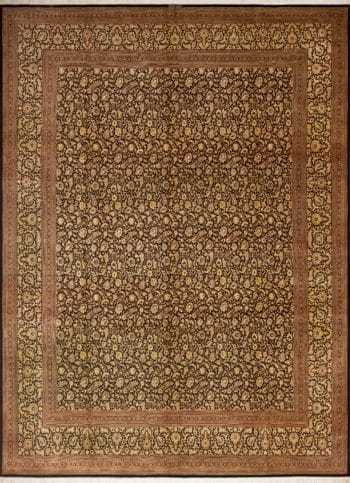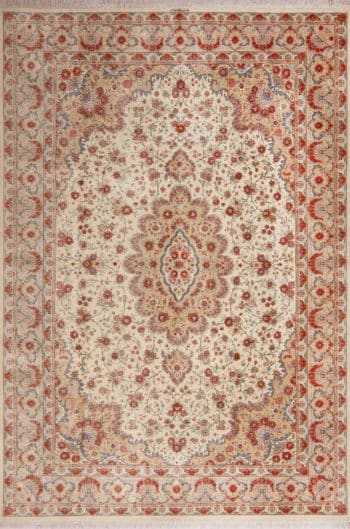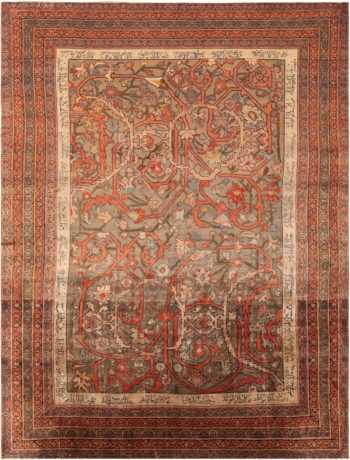Silk Persian Rugs
Modern Vintage Silk Persian area Rugs
-
Oversized Antique Persian Silk Tabriz Haji Jalili Rug 48981
$320,000.00Size: 15 ft 8 in x 24 ft 6 in (4.78 m x 7.47 m) -
Silk Large Antique Persian Tabriz Rug 71986
$96,000.00Size: 12 ft 2 in x 19 ft (3.71 m x 5.79 m) -
Rare Fine High Quality Antique High End Luxurious Persian Silk Haji Jalili Tabriz Area Rug 7991
Size: 10 ft 7 in x 14 ft 5 in (3.23 m x 4.39 m) -
Luxurious Room Size Ivory Allover Floral Design Fine Vintage Silk Persian Qum Rug 72757
$53,550.00Size: 10 ft x 13 ft 9 in (3.05 m x 4.19 m) -
Luxurious Room Size Silk Vintage Blue Persian Fine Qum Gonbad Design Rug 72741
$38,150.00Size: 9 ft 7 in x 13 ft 9 in (2.92 m x 4.19 m) -
Fine Room Size Vintage Persian Luxury Gonbad Design Silk Qum Rug 72759
$45,150.00Size: 10 ft x 13 ft 8 in (3.05 m x 4.17 m) -
Red Fine Floral Luxurious Vintage Persian Qum Silk Hallway Runner Rug 72787
$15,050.00Size: 2 ft 9 in x 13 ft 7 in (0.84 m x 4.14 m) -
Fine Floral Long Narrow Gallery Size Vintage Luxury Persian Silk Qum Rug 72744
$26,250.00Size: 5 ft 2 in x 13 ft 6 in (1.57 m x 4.11 m) -
Fine Luxurious Silk Formal Medallion Room Size Persian Qum Rug 49398
$53,200.00Size: 9 ft 6 in x 13 ft 6 in (2.9 m x 4.11 m) -
Extremely Fine Weave Floral Central Medallion Vintage Room Size Persian Silk Qum Rug 70244
$52,500.00Size: 9 ft 9 in x 13 ft 5 in (2.97 m x 4.09 m) -
Fine Room Size Vintage Persian Silk Qum Rug 70245
$46,900.00Size: 10 ft x 13 ft 4 in (3.05 m x 4.06 m) -
Fine Luxurious Floral Design Vintage Persian Qum Silk Hallway Runner Rug 72792
$15,750.00Size: 2 ft 7 in x 13 ft 3 in (0.79 m x 4.04 m) -
Fine Floral Vintage Persian Gonbad Design Silk Qum Luxury Hallway Runner Rug 72789
$15,050.00Size: 2 ft 8 in x 13 ft (0.81 m x 3.96 m) -
Fine Traditional Vintage Persian Silk Qum Luxury Rug 72758
$30,975.00Size: 9 ft 10 in x 13 ft (3 m x 3.96 m) -
Luxurious Fine Floral Vintage Persian Silk Qum Hallway Runner Rug 72790
$15,750.00Size: 2 ft 8 in x 13 ft (0.81 m x 3.96 m) -
Fine Luxurious Ivory Background Antique Allover Floral Silk Persian Kashan Area Rug 71817
$125,000.00Size: 9 ft x 13 ft (2.74 m x 3.96 m) -
Fine Antique Persian Silk Heriz Carpet 47239
$68,000.00Size: 10 ft x 13 ft (3.05 m x 3.96 m) -
Fine Long Narrow Gallery Size Vintage Garden Design Silk Persian Qum Rug 72743
$26,250.00Size: 5 ft 2 in x 12 ft 10 in (1.57 m x 3.91 m) -
Fine Allover Floral Design Luxurious Room Size Vintage Persian Silk Qum Rug 72742
$31,850.00Size: 9 ft 9 in x 12 ft 10 in (2.97 m x 3.91 m) -
Fine Luxurious Persian Qum Silk Hallway Runner Rug 72786
$15,050.00Size: 2 ft 7 in x 12 ft 9 in (0.79 m x 3.89 m) -
Fine Intricate Floral Vintage Persian Silk Qum Hallway Runner Rug 72754
$18,550.00Size: 3 ft 7 in x 12 ft 9 in (1.09 m x 3.89 m) -
Beautifully Luxurious Fine Antique Persian Silk Heriz Masterpiece Rug 71939
Size: 8 ft 4 in x 12 ft 6 in (2.54 m x 3.81 m) -
Fine Luxurious Floral Room Size Vintage Persian Silk Qum Rug 72745
$26,250.00Size: 8 ft 2 in x 11 ft 7 in (2.49 m x 3.53 m) -
Luxurious Fine Silk Antique Persian Heriz Area Rug 71577
Size: 8 ft 5 in x 10 ft 10 in (2.57 m x 3.3 m)
Breathtaking Collection of Finely Woven Antique, Vintage and Modern Silk Persian Rugs
Shop Our Antique Persian Rugs | View Images Of Silk Persian Rugs
What is a vintage silk Persian rug?
A vintage silk Persian rug is a traditional Persian rug that is characterized by its use of silk fibers and its age, typically being several decades old.
Here are some key features and characteristics of vintage silk Persian rugs:
- Material: These rugs are made from silk, a luxurious and delicate natural fiber. Silk is known for its softness, sheen, and fine texture, making it a prized material for rug weaving.
- Origin: Persian rugs originate from Iran (formerly Persia), and they are renowned for their quality and craftsmanship. The term “Persian rug” is often used to describe handwoven rugs from this region.
- Age: Vintage Persian rugs are aged, typically ranging from 20 to 100 years old. The age contributes to their character, uniqueness, and often enhances their value.
- Designs and Patterns: Persian rugs are known for intricate and detailed designs. They often feature elaborate floral patterns, medallions, and motifs that represent cultural and artistic traditions specific to the region.
- Colors: Vintage silk Persian rugs may exhibit a rich and vibrant color palette. Traditional colors include deep reds, blues, greens, and golds. The use of silk can enhance the intensity and luminosity of the colors.
- Hand-Knotted Craftsmanship: These rugs are hand-knotted by skilled artisans. The labor-intensive process of hand-knotting ensures durability and a high level of craftsmanship. The knots per square inch (KPSI) can be an indicator of the rug’s quality.
- Sheen and Luster: The silk fibers in these rugs contribute to a luxurious sheen and luster. This characteristic enhances the overall appearance and elegance of the rug.
- Collectible and Valuable: Vintage silk Persian rugs are often considered valuable collector’s items due to their age, craftsmanship, and the use of silk. They are sought after by rug enthusiasts and collectors around the world.
- Care: Due to the delicate nature of silk fibers, these rugs may require special care. It’s essential to handle them gently, avoid exposure to direct sunlight, and follow proper cleaning methods.
When considering a vintage silk Persian rug, it’s advisable to purchase from reputable dealers or rug experts who can provide information about the rug’s origin, age, and authenticity. These rugs not only serve as functional floor coverings but also as works of art that can add beauty and cultural richness to interior spaces.
What makes Persian silk rugs so special?
Persian silk rugs are considered special and highly valued for several reasons, including their luxurious materials, intricate craftsmanship, cultural significance, and timeless beauty.
Here are some factors that contribute to the uniqueness and special qualities of Persian silk rugs:
- Silk Material: Persian silk rugs are made from silk fibers, a natural material known for its softness, sheen, and fine texture. Silk adds a luxurious and elegant touch to the rug, enhancing its overall beauty.
- Intricate Designs: Persian rugs, including those made of silk, are renowned for their elaborate and intricate designs. These designs often feature detailed floral patterns, medallions, and motifs that reflect the rich cultural heritage of Iran. The level of detail and precision in the designs is a testament to the craftsmanship of Persian rug weavers.
- Hand-Knotted Craftsmanship: Persian silk rugs are hand-knotted, a labor-intensive and traditional method of rug making. Skilled artisans meticulously tie individual knots to create the intricate patterns. The hand-knotting process contributes to the durability and longevity of the rug.
- Rich Color Palette: Persian silk rugs often boast a rich and vibrant color palette. Traditional colors include deep reds, blues, greens, golds, and other jewel tones. The use of silk enhances the luminosity and intensity of these colors, creating a visually striking effect.
- Cultural Heritage: Persian rugs hold a significant place in the cultural heritage of Iran. The designs often carry symbolic meanings and reflect the artistic traditions passed down through generations. Owning a Persian silk rug is a way of bringing a piece of this cultural heritage into one’s home.
- Collector’s Items: Antique and vintage Persian silk rugs are often considered valuable collector’s items. Their age, rarity, and craftsmanship contribute to their desirability among collectors and rug enthusiasts. Some rugs may appreciate in value over time.
- Luxurious Texture: The use of silk gives Persian rugs a luxurious and silky texture. Walking or sitting on a silk rug is a tactile experience that adds to the overall sense of opulence.
- Timeless Appeal: Persian silk rugs have a timeless and classic aesthetic that transcends design trends. Their beauty and craftsmanship make them suitable for various interior styles, ensuring that they remain relevant and cherished over the years.
- Attention to Detail: Persian rug weavers pay meticulous attention to detail, ensuring precision in every aspect of the rug. This attention to detail contributes to the overall quality and beauty of the finished product.
- Cultural Recognition: Persian silk rugs are globally recognized as symbols of quality and artistry. The demand for these rugs extends beyond Iran, and they are sought after by collectors and individuals worldwide.
In summary, Persian silk rugs are special due to their use of luxurious materials, intricate designs, cultural significance, and the craftsmanship involved in their creation. These rugs not only serve practical purposes as floor coverings but also stand as works of art that embody a rich cultural legacy.
How do people decorate around a silk Persian area rug?
Decorating around a silk Persian area rug involves creating a harmonious and visually appealing space that complements the rug’s elegance and intricate design.
Here are some tips on how to decorate around a silk Persian area rug:
- Choose a Central Color: Use the dominant color of the Persian rug as a central theme for the room’s color palette. This creates cohesion and ensures that the rug becomes a focal point.
- Coordinate Furniture Colors: Select furniture pieces with colors that harmonize with the rug. Neutral-colored furniture or pieces that match the secondary colors in the rug can create a balanced look.
- Balance Patterns: If the Persian rug has intricate patterns, balance them with simpler patterns or solid colors in furniture and accessories. Avoid overwhelming the space with too many competing patterns.
- Select Complementary Fabrics: Choose upholstery fabrics, curtains, and throw pillows that complement the texture of the silk rug. Luxurious and tactile fabrics can enhance the overall opulence of the space.
- Add Accent Pieces: Introduce accent pieces in colors found in the Persian rug to tie the room together. This can include decorative items, vases, or artwork that echo the rug’s color scheme.
- Layering Rugs: Consider layering a smaller rug on top of the Persian rug to add texture and interest. Ensure that the additional rug complements the colors and style of the Persian rug.
- Use Mirrors: Mirrors can reflect the intricate patterns of the rug and create a sense of spaciousness. Placing mirrors strategically can enhance the overall visual impact of the room.
- Incorporate Greenery: Bring in indoor plants to add a natural element to the space. Greenery complements the rich colors of the rug and adds a touch of freshness.
- Lighting: Consider lighting that enhances the silk fibers’ sheen and illuminates the rug. Pendant lights, table lamps, or floor lamps can contribute to the overall ambiance of the room.
- Frame the Rug: Arrange furniture in a way that frames the silk Persian rug. Allow the rug to be a central point in the seating arrangement, emphasizing its beauty.
- Create a Cozy Seating Area: Arrange furniture in a way that creates a cozy seating area around the rug. This encourages conversation and draws attention to the rug as a focal point.
- Minimalist Approach: Allow the Persian rug to shine by adopting a minimalist approach to decor. Choose a few statement pieces that complement the rug without overcrowding the space.
Remember that personal taste plays a significant role in decorating, and these tips can be adjusted based on individual preferences. The goal is to create a space that showcases the beauty of the silk Persian rug while maintaining a cohesive and inviting atmosphere.
Why are the silk Persian area rugs so fine and intricate?
Silk Persian area rugs are renowned for their fine and intricate craftsmanship.
Here are several factors contribute to their exceptional quality:
- Material Quality: The primary factor that contributes to the fineness of silk Persian rugs is the use of silk as the primary material. Silk is a luxurious and fine natural fiber known for its softness, sheen, and delicate texture. The use of high-quality silk fibers results in a rug with a luxurious feel and a smooth, fine surface.
- Hand-Knotting Technique: Silk Persian rugs are typically hand-knotted, a traditional and labor-intensive technique. Skilled artisans tie individual knots by hand to create the intricate patterns and designs. The hand-knotting process allows for a high level of detail and precision in the rug’s construction.
- High Knots Per Square Inch (KPSI): The number of knots per square inch (KPSI) is a key indicator of a rug’s quality and intricacy. Silk Persian rugs often have a high KPSI, meaning that there are a significant number of knots tightly packed within each square inch of the rug. A higher KPSI allows for more detailed patterns and a smoother overall appearance.
- Elaborate Designs: Persian rugs are known for their elaborate and intricate designs, featuring motifs, floral patterns, and medallions that are specific to the region’s cultural heritage. The combination of detailed designs and the use of fine silk allows weavers to create visually stunning and complex patterns.
- Artisanal Expertise: The creation of silk Persian rugs involves skilled craftsmanship passed down through generations. Artisans who specialize in rug weaving possess expertise in selecting and working with silk fibers, as well as the intricate process of hand-knotting.
- Cultural Tradition: The tradition of weaving fine and intricate rugs is deeply ingrained in the cultural heritage of Iran. Persian rug weaving has been practiced for centuries, and the art has been refined over time to produce some of the world’s most exquisite rugs.
- Attention to Detail: Weavers pay meticulous attention to detail during the entire rug-making process. From selecting high-quality silk to tying each knot with precision, the attention to detail ensures the overall quality and beauty of the finished rug.
- Natural Dyes: Traditional Persian rugs often use natural dyes derived from plants, insects, and minerals. The use of natural dyes contributes to the richness and depth of color in the rug, enhancing its overall visual appeal.
The combination of these factors results in silk Persian area rugs that are not only fine and intricate but also represent a rich cultural heritage and a dedication to craftsmanship. These rugs are considered works of art, prized for their beauty, quality, and the skill involved in their creation.
Why are Persian silk rugs considered the best type of silk rugs?
Persian silk rugs are often considered among the best silk rugs in the world due to a combination of factors that contribute to their exceptional quality and reputation.
Here are some reasons why Persian silk rugs are highly regarded:
- Cultural Heritage: Iran (formerly Persia) has a rich and ancient tradition of rug weaving that spans centuries. The art of Persian rug making has been passed down through generations, and the weavers’ expertise is deeply rooted in the country’s cultural heritage.
- Skilled Craftsmanship: Persian silk rugs are hand-knotted by skilled artisans who have honed their craft over many years. The hand-knotting technique allows for intricate patterns and a high level of detail, showcasing the weavers’ craftsmanship.
- Fine Silk Material: Persian silk rugs use high-quality silk as the primary material. Silk is known for its luxurious feel, sheen, and fine texture. The use of fine silk fibers contributes to the rug’s softness and elegance.
- High Knots Per Square Inch (KPSI): Persian silk rugs often have a high number of knots per square inch (KPSI). A higher KPSI allows for more detailed patterns and a smoother surface. The density of knots is indicative of the rug’s quality and intricacy.
- Elaborate Designs: Persian rugs are renowned for their elaborate and intricate designs, featuring floral motifs, medallions, and other cultural symbols. The complexity of the designs showcases the artistic expression and creativity of the weavers.
- Natural Dyes: Traditional Persian silk rugs often use natural dyes derived from plants, insects, and minerals. The use of natural dyes adds depth and richness to the colors, and it is considered a more environmentally friendly and authentic approach to coloring.
- Collector’s Value: Antique and vintage Persian silk rugs are highly sought after by collectors. Their age, craftsmanship, and cultural significance contribute to their collector’s value, making them prized possessions.
- Versatility and Timelessness: Persian silk rugs are known for their versatility and timeless appeal. They can seamlessly complement a variety of interior design styles, and their beauty remains enduring despite changing design trends.
- Global Recognition: Persian silk rugs have gained global recognition and are often considered a symbol of luxury and quality. The reputation of Persian rugs as some of the finest in the world adds to their desirability.
- Attention to Detail: Persian rug weavers pay meticulous attention to detail throughout the rug-making process. From selecting the silk fibers to tying each knot, the commitment to precision ensures a high-quality finished product.
It’s important to note that within the category of silk rugs, there are variations in quality and style based on the specific region of production, the individual weaver’s expertise, and the design traditions of that particular area. While Persian silk rugs are highly esteemed, other regions with a history of silk rug production, such as Kashmir and Turkey, also produce exceptional silk rugs with unique characteristics. Ultimately, personal preferences and the specific qualities one values in a rug play a role in determining which silk rug is considered the best for individual tastes.
Why are silk Persian rugs so expensive?
Silk Persian rugs are often expensive due to a combination of factors that contribute to their high cost.
Here are some reasons why silk Persian rugs command a premium price:
- Fine Materials: Silk, the primary material used in these rugs, is a luxurious and fine natural fiber. The quality of silk greatly influences the overall cost of the rug. High-quality silk is more expensive, and Persian silk rugs often use the finest grades of silk available.
- Hand-Knotting Technique: Silk Persian rugs are traditionally hand-knotted, a labor-intensive and time-consuming technique. Skilled artisans meticulously tie individual knots by hand to create intricate patterns. The hand-knotting process requires a significant amount of time and expertise, contributing to the rug’s higher cost.
- Artisanal Craftsmanship: The craftsmanship involved in creating silk Persian rugs is highly skilled and specialized. Artisans who have mastered the art of rug weaving often work for extended periods to produce a single rug. The level of expertise and the dedication of skilled craftsmen contribute to the rug’s value.
- High Knots Per Square Inch (KPSI): Persian silk rugs often have a high number of knots per square inch (KPSI), indicating a dense and intricate weave. Achieving a high KPSI requires more time and effort, adding to the overall cost of production.
- Elaborate Designs: Persian rugs are renowned for their elaborate and intricate designs. The complexity of the designs, often featuring detailed floral patterns, medallions, and motifs, requires careful planning and execution. The artistic value of these designs contributes to the rug’s price.
- Natural Dyes: Traditional Persian silk rugs often use natural dyes derived from plants, insects, and minerals. The use of natural dyes is a meticulous and time-consuming process that enhances the rug’s colors. The cost of obtaining and preparing natural dyes can contribute to the overall expense.
- Cultural Heritage: The cultural significance of Persian rugs and the rich heritage of rug weaving in Iran contribute to their perceived value. The centuries-old tradition of creating high-quality rugs is reflected in the craftsmanship, design, and attention to detail, elevating their worth.
- Collector’s Items: Antique and vintage Persian silk rugs are often considered collector’s items. The age, rarity, and historical value of these rugs can significantly increase their price, especially if they are well-preserved and in excellent condition.
- Global Demand: Persian silk rugs have a global reputation for quality and beauty. The high demand for these rugs in international markets can influence their pricing, as they are sought after by collectors and individuals worldwide.
- Customization: In some cases, buyers may choose to commission custom-made Persian silk rugs with specific designs, colors, and dimensions. Customization adds an additional layer of craftsmanship and personalization, contributing to higher costs.
While the expense of silk Persian rugs can be substantial, many buyers view them as valuable investments due to their quality, beauty, and potential to appreciate in value over time. The combination of fine materials, skilled craftsmanship, and cultural significance contributes to the premium pricing of these luxurious rugs.
More about the silk Persian rugs
However they may be woven, most area rugs are commonly made of wool. If they are pile carpets, their pile consists mostly of wool even if their foundation is cotton. The same is true of the weft face of tapestry or kilim rugs. But as luxury items Persian carpets came at some point to be made in the far more precious material of silk. If this began already in the Mongol or Timurid periods, it would hardly be surprising given the close ties between Persia and China at that time, for it was in China that silk production or seri-culture first began.
But seri-culture had already been established in Persia since the Sassanian period (3rd to 7th centuries) when its secret of production along with a supply of silkworms was presumably smuggled out of China. In due course Persia became a center of silk textile production. It was therefore inevitable that the weavers of the Silk Road would eventually hit upon the idea of making carpets in silk.
But whenever or wherever this first began, the Safavid period was when the use of silk fibers became an established component of Persian rug weaving. Given the superior strength of silk fibers and their finer proportions, silk came to used in the foundation of Persian carpets, as warps or wefts, or both. In due course smaller amounts of silk knots were used amidst the wool pile as highlights, then as the pile of larger details within the design, and finally to produce the pile in its entirety. Similarly, the weft face of kilims was at times produced in silk as well. Given the greater fineness of silk fibers, this material naturally lent itself to the extreme delicacy that Persian rug weaving sought to achieve.
Since silk naturally has a more reflective, lustrous quality and softer texture than even the finest wool, it offered the possibility to achieve a more luminous, glowing, and luxurious carpet. And so today silk continues to be used in foundations, as highlights amidst wool pile, or as the primary material for the pile in the very finest Persian carpets as it has for centuries, an enduring testament to Persia’s continued status as a leader in traditional oriental area rug production.
Persian silk area rugs are a special class in the world of fine Persian rugs. Silk has several qualities, aside from its luster, that make these rugs a rare find and beautiful addition to a collection.
Finer threads can be spun with silk than with wool. These can be used to create extremely intricate designs and rugs with higher knot counts. This allows the artisans to create rugs of fine detail and exceptional beauty. During the Safavids Dynasty, only specially-trained spinners and weavers were allowed to work with silk because of its high value to the Courts.
Throughout the ages, working with silk remained an area of art and design that was reserved for guild members and those who possessed a high level of skill and knowledge. Silk takes dyes well, and many of the colors remain vibrant for decades.
This collection of specifically Persian made silk area rugs features a range of sizes from small accent rugs to room-size and oversize pieces. The natural characteristics of silk allow these rugs to achieve a high level of detail. You will find complex designs with intricate borders, pictorials, and details that you will not find in other rug types. Silk was reserved for an exclusive class of artists who proved themselves in the design and technical skills required to create these magnificent pieces.
Many rugs in this collection were created during the latter part of the 20th century. They feature traditional designs and show many of the same qualities as their antique predecessors. A fine silk rug makes a statement in the room and adds a refined character to the space. Rugs from this collection area phenomenal additions to a traditional design or can be used to add vibrancy to a contemporary design.
The beauty of a fine silk rug from Persia is something that must be experienced to understand, and Nazmiyal Gallery is proud to bring you this fine collection of some of our favorites. We encourage you to browse some of these masterful selections. If you see one you like, you can contact our staff for any questions that you have and arrange for a delivery option that works for you.
Why do people pay so much for silk Persian rugs?
Silk Persian rugs are highly valued and sought after for several reasons.
Here are some of the factors that make Silk Persian rugs so expensive:
- Craftsmanship and Artistry: Silk Persian rugs are often handmade using traditional weaving techniques that have been passed down through generations. Skilled artisans spend months or even years weaving intricate patterns and designs into the rug. The level of craftsmanship and attention to detail is a testament to the artistry that goes into creating each piece.
- Material Quality: Silk is a luxurious and delicate material that requires careful handling and processing. It is often more labor-intensive to work with silk fibers than with other materials like wool. The high-quality silk used in Persian rugs adds to their exclusivity and cost.
- Intricate Designs and Patterns: Persian rugs are renowned for their intricate and elaborate designs, often inspired by cultural and historical motifs. These designs require a deep understanding of geometry, color theory, and artistic techniques. The complexity of the patterns contributes to the value of the rug.
- Historical and Cultural Significance: Persian rugs have a rich history dating back centuries. They are often considered cultural treasures and symbols of prestige. The heritage and tradition associated with these rugs contribute to their desirability and high price.
- Limited Supply and Rarity: Handmade silk Persian rugs are produced in limited quantities, and creating them is a time-consuming process. As a result, there is a relatively low supply of these rugs, which can drive up demand and prices.
- Durability and Longevity: Silk Persian rugs are known for their durability and longevity. When well cared for, they can last for generations and maintain their beauty over time. The investment in a silk Persian rug is often seen as a long-term one.
- Labor-Intensive Process: Weaving a silk Persian rug is a labor-intensive process that requires a high level of skill and dedication. From preparing the silk fibers to meticulously hand-knotting the rug, every step of the process contributes to the overall cost.
- Investment Value: High-quality silk Persian rugs are often considered valuable assets and investments. Their rarity, craftsmanship, and historical significance can lead to appreciation in value over time, making them attractive to collectors and investors.
- Aesthetic Appeal: Silk Persian rugs have a distinct luxurious and lustrous appearance that can elevate the aesthetics of any space. Their ability to transform a room and create a sense of opulence adds to their allure and value.
- Global Demand: Persian rugs, especially those made of silk, have a global reputation for their beauty and quality. Collectors, interior designers, and connoisseurs from around the world seek out these rugs, driving up demand and contributing to their high price.
In summary, the combination of meticulous craftsmanship, high-quality materials, intricate designs, historical significance, and limited supply all contribute to the premium price tag associated with the luxurious, handcrafted, fine, silk Persian area rugs.

